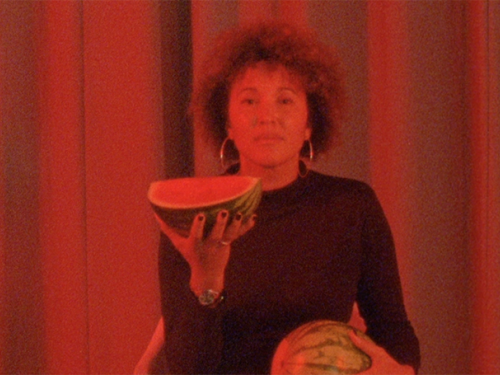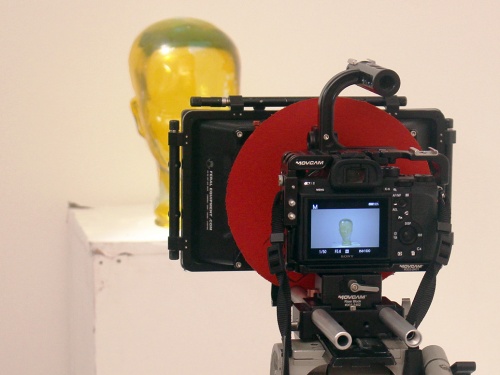In My Mind I Can Go Anywhere
Making a short film about art, animation and disability
Following the screening of her short film at the ICA in Playback Festival: in association with Random Acts, deaf and disabled filmmaker Jemima Hughes describes the process of making her First Acts film, Imagination.
I am passionate about filmmaking, and I am disabled. I am profoundly deaf and have cerebral palsy, use a wheelchair, can’t use my hands, talk with an electronic communication aid and access my computer with a voice-activated switch. Although I took every opportunity to get involved in filmmaking projects at school and college and in my community, I was unable to access filmmaking courses, so in 2014 I started making short documentaries and paper-cut animations at a creative centre for disabled adults, ARRCC Folkestone, where I could work on both individual and group projects.
The Screen South Ignition Random Acts scheme was both a huge challenge and a fantastic opportunity to develop the artistic and technical quality of my filmmaking. It enabled me to work with an experienced professional team and a supportive and creative mentor, Jes Benstock, who helped me think more deeply about my ideas and decisions.
My short film Imagination was inspired by the paper cut-outs Matisse made when he was old and disabled. That’s a good style for me, because I can draw simple shapes with support and I had already made a short animation using this style. I love the vivid colours and sense of movement and celebration. Many stories and films show pictures or objects coming to life; in Imagination my mind brings pictures in an exhibition to life, just as animation magically makes images move.
First I chose paper cut-outs of dancers and acrobats. Then, after I saw the long, white hand on a guitar in Matisse’s beautiful Sorrow of the King, I knew I wanted to recreate this image with characters who would sign to me. I understand and think in sign language, which tells stories visually in moving pictures – maybe that’s why I love film and animation so much. “Cat” and “dog” are simple signs to cut out and animate, and viewers without knowledge of signing can easily relate them to the animals which appear when the signs summon them.
I understand and think in sign language, which tells stories visually in moving pictures – maybe that’s why I love film and animation so much
The last Matisse paper cut-out that I chose to adapt was the pony and cart, which allowed me to say something about access and movement – not just in my mind, but in the real world. On Dartmoor, for example, there is a specially adapted pony and cart that takes people in wheelchairs into some of the most inaccessible places: "In my mind I can go anywhere. With imagination all becomes accessible."
I particularly enjoyed creating the short, abstract transitions based on shapes from the paper cut-outs, which convey the feelings of the character and the impact of her interaction with the pictures. For me, shape, colour and movement often express feelings more easily than words can, and that’s something I plan to develop in future projects.
Making a broadcast quality film was a huge learning curve for me. Screen South gave great support with production and technical requirements; I learned to make an animatic by photographing my storyboard onto a timeline to check the flow and adjust the timing of the storyboard and script. Then my mum and my PA spent long days tracing my drawings and cutting out the figures and backgrounds, some of them in several sizes so that close up shots of the jumping cat or signing hands could move with the necessary precision. The six days I spent shooting with animator Astrid Goldsmith were exhausting but magical, as my ideas and images came to life.
For me, shape, colour and movement often express feelings more easily than words can
My deafness makes sound design difficult, but composer Mike Roberts listened to my ideas about using different instruments for each character, emphasising the magical moments when pictures start to move and the emotional progression from the sad, slow opening scene to the exuberant finale. He created music which perfectly expresses the changing mood and imaginative interaction with the artworks.
I was determined that my film should have open captions, and planned my storyboard with space for subtitles in a paper cut-out font which matches the die-cut letters in the animation. It’s frustrating for me that almost none of the First Acts films have been subtitled – I would like everyone to be more open to watching films with subtitles. I also want the voices of AAC (augmentative and alternative communication) users to be more widely heard and accepted in the media. My electronic voice is part of my identity, and much of my work has focused on disability and communication and celebrated disabled people’s lives and creativity.
Imagination is not just a film about disability. It’s about passion for art and animation, showing how imagination and creativity transform and enrich my life. The last words of the film also reflect the experience of making it: "Imagination animates my world, filling it with vivid colour." ■
Jemima's film Imagination is being exhibited as part of the national Playback Touring Exhibition in association with Random Acts, currently at Peckham Platform until 2 April
This article is posted in: Articles, Exhibitions
Tagged with: Playback Festival, Playback, Filmmaking, Animation, Artist Moving Image











